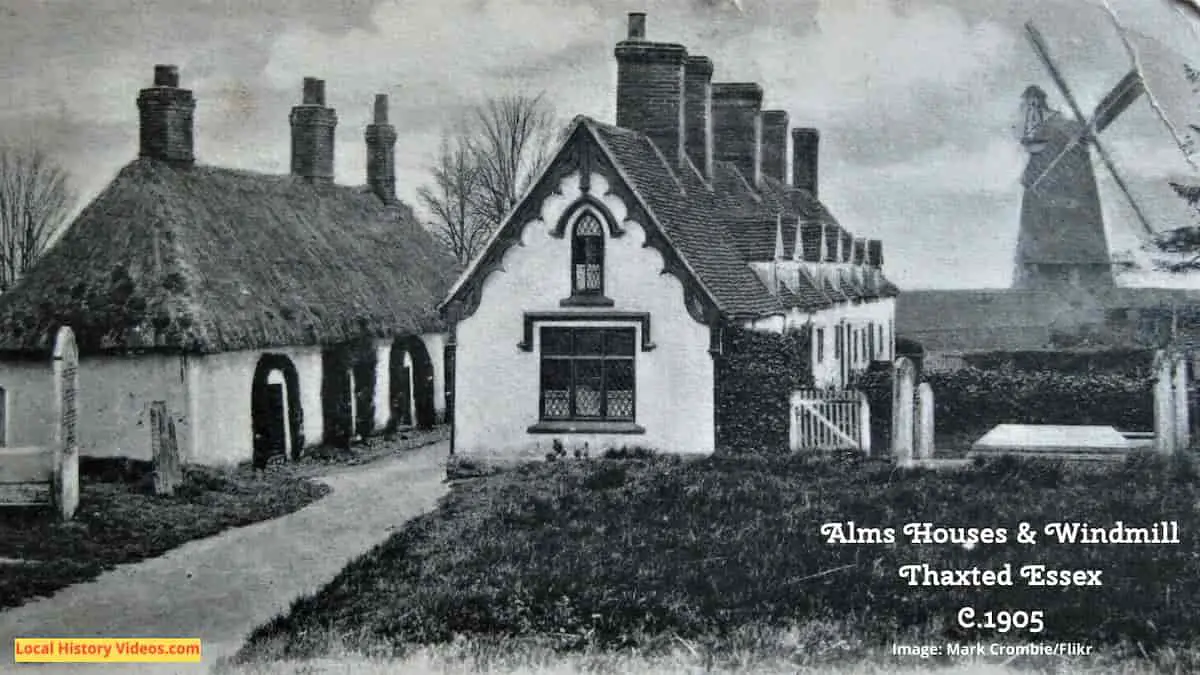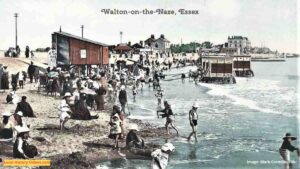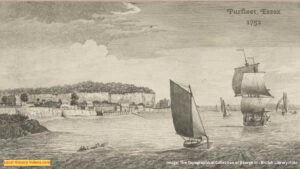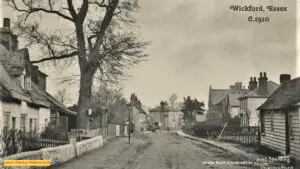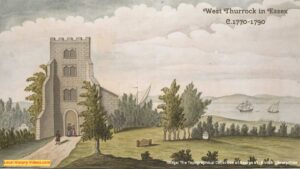Glimpse history through old images of Thaxted, Essex, England.
Robot Elephant 1950
Thaxted’s robotic elephant was invented by Mr Frank Stewart, who was inspired by the donkey rides commonly seen on Britain’s beaches in that era.
Thaxted Part Of World News (1950) – British Pathé on YouTube
Thaxted in 1961
A short newsreel in 1961 captures Thaxted’s charm as a countryside haven away from hectic London. It shows the Recorder’s House and Guildhall, built when the cutlery trade and wool were important industries in the area, and the disused windmill.
But what the newsreel also did was film local people, shops, homes and businesses at a time when British life was rapidly changing, even if the historic buildings were not.
The woolen weaver Arthur Caton and woolen carder and spinner Kate Butters are shown using traditional methods to create ties. Meanwhile, the The Reverend Putterill, Vicar of Thaxted’s church, is shown at his home made observatory in the vicarage grounds.
Village Observatory (1961) – British Pathé on YouTube
Historic Book
Extract from:
The People’s History of Essex, Comprising a Narrative of Public and Political Events in the County, from the Earliest Ages to the Present Time : the Hundreds and Boroughs, with Descriptive Sketches of Their Antiquities and Ruins, the Seats of the Nobility and Gentry, and an Epitome of the Parochial Charities
by Duffield William Coller
Published in 1861
Pages 299 – 302
Thaxted. – Three miles and a half further onward, and we enter the town of Thaxted. As we advance through the long and somewhat irregular and straggling street, it is seen at a glance that it is not one of the mushroom towns of yesterday. The shape of the old gables, and the projecting upper stories of many of the houses, bear the impress of centuries long past, and some of the buildings present fine specimens of the domestic architecture of other days.
The hand of improvement, however, has made havoc of these relics, for though a writer of the last century says “the houses are not to be boasted of for their elegant construction,” the modern architect has since then descended upon them with pencil and improving trowel in hand, rebuilding mansions, remodelling shop fronts; and, in the glory of paint and plate glass, it now presents as respectable an appearance as any town of its size in the county.
It has been thought by some that the town was at one period much more extensive than at present. This arises from the terms in which places are often spoken of in ancient records. Thaxted, even in its palmiest days, when it sat under the shadow of the fostering protection of the great families who ruled around and within it, could not muster one-half of the population it can now.
For instance, at the time of the dissolution of the chantries, it was set forth in an official document relating to them, that “This towne was then a great and populous towne and a markett and thoroughfare towne, havyng in yt by estimation about the number eight hundred housling people.”
The place, however, seems to have been of importance even in the time of the Saxons, and the church and its revenues belonged to the College of St. John the Baptist, at Clare, having apparently been given as part of its endowment on its foundation in the time of Edward the Confessor.
When the Conqueror came, followed by his host of hungry Normans, Wisgar, a man of large possessions in the county, was lord here, but he was expelled by the strong hand, and Thaxted was given to Richard Fitz-Giselbert, who was a relative of the new king.
This intruder was loaded with immense estates, and he was the founder of the great family of the Earls of Clare.
In the male line of this family, the lordship continued, carrying with it the stewardship of the forest of Essex for more than three centuries; till in 1314 Gilbert de Clare was killed at the battle of Bannockburn, where he led the English van.
It then descended to the female branch, and in 1341 it was divided between four co-heirs.
Three of the shares were, however, reunited, and passed through various families.
It was more than once forfeited to the crown in the turmoils of the time; and being settled by Henry VIII. in 1509 as a dower upon Queen Katharine of Arragon, it came, about 1600, into the family of Smith, and Sir William Bowyer Smith, of Hill Hall, was until recently the lord paramount.
Besides this chief lordship, there are five other manors, the lands of some running into neighboring parishes.
Lord Maynard owns Yardleys, the rectory, and Priors Hall; and Richmonds and Thaxted Lodge were purchased by Guy’s Hospital in 1720.
A charter for a fair here was obtained by the Earl of Gloucester, about 1310 or 1312, to be held on the eve, the day, and the morrow of St. Luke; there are now two fairs for cattle, one on the Monday before Whitsuntide, and the other on the 10th of August.
The market, which was on Fridays, has been extinguished; an attempt was made at the beginning of the present century to revive it, but it failed.
Thaxted was anciently a corporation, and it seems probable that in some cases it sent members to the great council of the nation; but the glory of the gold chain and the terror of the mace have long since departed from it.
It is generally represented as having been first incorporated by Philip and Mary, by the title of “mayor, bailiffs, and commonalty of the town of Thaxted,” but we find it frequently mentioned as a borough long before that period.
The mother of Richard III. had a grant from her son of the manor and borough of Thaxted in 1483.
Katharine of Arragon, in 1514, granted the manor and borough of Thaxted to Sir John Cutts.
It is probable, therefore, that the charter of Philip and Mary was only a formal recognition of rights and privileges which had been substantially possessed and exercised centuries before.
It might be supposed from this special favor of the merciless Mary that the town was a stronghold of the Roman Catholic party, but if so, the inhabitants had acquired the art of readily turning according to the direction of the state wind, which many found so profitable at that period, as Queen Elizabeth gave her full
confirmation to the charter.
James I. increased their power and privileges. Through five reigns, the town enjoyed the dignity of a corporation, the members meeting in solemn council in the guild hall, using the common seal, though they never appear to have possessed the right to a coat of arms.
Dues were levied, and it would seem quarter sessions were held for the trial of offenses committed within the liberty, as Serjeant Bendlowe, who resided here, is believed to have been the first recorder, and it appears, by a record of a visitation of the heralds, that George Scott, Esq., of Lincoln’s Inn, held that office in 1637.
We learn, from the same document, that Robert Humphrey was then mayor and a justice of the peace within the borough; John Halls and Thomas Clark were the bailiffs, and there were 20 chief burgesses, of whom 10 had been mayors.
The arbitrary hand of James II., however, extinguished the civic honors of the town. In the course of that monarch’s general onslaught upon the corporations, a quo warranto was served upon Thaxted, questioning its rights, and calling upon its authorities to prove them in a court of law.
A legal contest with the crown alarmed the mayor, and startled the burgesses.
There is no trace of any corporate estates from which the costs could have been defrayed.
It was resolved, therefore, to offer no defense. The mayor descended from his seat, the officers doffed their civic robes, and the deserted guild or moot hall was left to decay, and remained useless until 1714, when the council chamber above the ancient market-house was repaired, and has since been used as a school.
There were two other guild halls in the town, used by the religious bodies of the old times, one of which stood on the south side of the churchyard, and Morant says
“It probably belonged originally to the guild of St. John the Baptist, but was used in after times by the rest of the religious guilds, excepting that of the rood, which had a hall of its own. These guilds being all suppressed at the
reformation, the house was for some time let out for the keeping of public weddings, on which occasion the fee paid for the use of it was 16d., and called the bridal.’
But in 1562 it was converted into a school, in which state it continued till the year 1711, from which time it has been the parish workhouse.”

